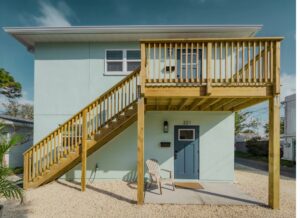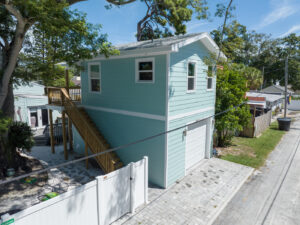Looking to build an Accessory Dwelling Unit (ADU)? One of the first decisions you’ll face is whether to opt for a tiny home kit or a custom-built ADU. Both options have their merits, but understanding the key differences and considering your specific needs will help you make the right choice.
ADUs have gained significant popularity in recent years as a practical and versatile housing solution. These secondary dwelling units, commonly located on the same property as the main house, offer various benefits, such as extra living space, potential rental income, and enhanced property value. Oftentimes, their smaller footprint means less build time and therefore less stress for the homeowner. But how easy is the construction process? Homeowners have a few options when it comes to building an ADU.
Tiny Home Kits
A “tiny home kit” is essentially a pre-manufactured housing unit, which arrives at your doorstep ready to assemble and install. They usually include all the materials needed to build the bare bones of a small house. If you’re the one who thrives in a DIY environment, a prefab tiny home is your call.
The pros/cons of prefab tiny homes:
- Quick and Easy Installation: The assembly process is often quick, allowing you to have a completed ADU in a matter of weeks if you’re prepared to put it together yourself or hire someone to install it.
- Cost-Effective: Tiny home kits are typically budget-friendly, with the average cost of a tiny home being $30,000 – $60,000. This makes it an attractive option for homeowners looking to add an ADU without breaking the bank.
- Limited Customization: While some tiny home kits offer a certain level of customization, you may have limited choices when it comes to design, layout, and finishes.
- Small Sizes: Prefab tiny homes are typically small, between 100-400 square feet.
- Potential Regulatory Hurdles: Depending on your local regulations, permitting for prefab tiny homes might not be as straightforward as custom-built ADUs. Some areas may have specific requirements for tiny homes depending on their foundation, which could slow down the process.
- Quality and Longevity: The quality and durability of tiny home kits may depend on the installation. It’s essential to research reputable manufacturers to ensure you’re investing in a high-quality kit.
Custom Built Tiny Homes
Custom built tiny homes, as the name suggests, are built from the ground up with your preferences and specific needs at the core. With custom built ADUs, you get the perfect chance to exercise your creativity, personalize every inch, and have superior control on quality. At CASK Construction, we bring our vast experience and professional expertise to build an ADU that reflects your vision, offering complete customer satisfaction.
- Tailored to Your Needs: The most significant advantage of a custom-built ADU is the ability to design and create a living space that perfectly suits your requirements. From layout and architecture to interior finishes and amenities, you have the freedom to personalize every aspect of the ADU.
- Higher Quality: Custom-built ADUs generally use higher-quality materials and craftsmanship compared to prefabricated options. This often results in a more durable and long-lasting structure that may require fewer repairs and maintenance in the long run.
- Adherence to Local Regulations: Custom-built ADUs can be better suited to meet specific local building codes and regulations. They allow for flexibility in complying with zoning laws, setbacks, and other restrictions that might be challenging to navigate with prefabricated kits.
- Longer Construction Timeline: One significant drawback of custom-built ADUs is the longer construction timeline. Building from scratch involves detailed planning, architectural drawings, and permits. At Cask we pride ourselves in getting you whole new living space, from concept to completion, in less than a year.
- Higher Cost: Due to the customized nature of these projects, custom-built ADUs are generally more expensive than prefabricated options. Costs can vary greatly depending on size, location, materials used, and complexity of design.
Settling on the Ideal Option: Prefab Tiny Home vs. Custom Built Tiny Home
Choosing between a tiny home kit and a custom built ADU can often feel like navigating the labyrinth. It boils down to understanding key parameters such as cost, construction timeline, customization, and overall dynamic. While prefab tiny homes can appear cheaper and quicker to install, custom built ADUs offer more flexibility and control.
Ask yourself the following questions:
- What is my budget for the ADU project?
- How much customization do I need or want for the living space?
- Am I willing to invest more time in planning and permitting for a custom-built ADU?
- Are there any specific zoning or building code requirements in my area that could impact my choice?
- Do I have a preferred construction timeline for the completion of the ADU?
By carefully evaluating your answers to these questions, you’ll be better equipped to make an informed decision that aligns with your lifestyle, budget, and project timeline.
Adding an ADU to your property is an excellent investment in your home’s value and your quality of life. Whether you opt for a custom-built ADU or a tiny home kit, each choice has its advantages and drawbacks. Consider your budget, timeline, and desired level of customization to determine which option is the right path for your ADU project. Whichever route you choose, an ADU is sure to enhance your property and provide a flexible living space for your current and future needs.
Looking to bring your ADU vision to life? Contact CASK Construction today! We’re all ears to consult, guide, and answer your queries about upcoming ADU projects. Allow us to join your journey to construct a space that feels truly your own!






